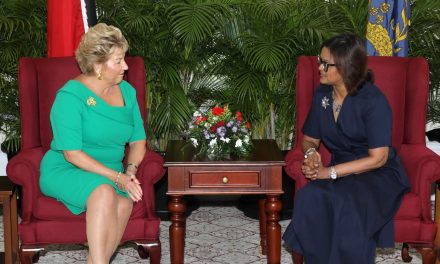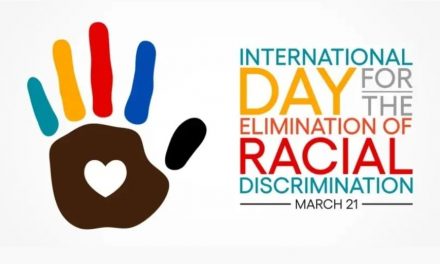II. Equal sharing of unpaid care and domestic work
III. An end to sexual harassment and violence against women and girls
IV. Health care services that respond to women’s needs
V. Equal participation in political life and in decision-making in all areas of life. And it is only a frank assessment of these indices that will allow us to draw reasonable conclusions as to whether the visibility of women represents real and measurable movement towards achieving gender equality; and I hope to engage you in just that exercise this evening as I have been pondering the question myself. I am certain that when Professor Barriteau so kindly invited me to address you at this Fifth Public Lecture to mark International Women’s Day, an invitation for which I express my deepest gratitude, she did not expect me to put the audience to work, but that’s a risk you take when you invite a woman to do a job. After all, we are known to work more collaboratively and are unafraid to ask for assistance. Before we begin, it must be noted that the 2020 Global Gender Gap Report concludes that none of us here present will see gender parity in our lifetime; the overall estimated timeframe for global gender parity has been put at 99.5 years, but while we count down, it might be useful to examine the aforementioned indices to determine whether we are ahead of the trend. Let us turn our attention first to the requirement of women earning equal pay for equal work. Education systems in the Caribbean, by and large, afford boys and girls equal access to education. Free primary and secondary education is widespread, with secondary school placement guaranteed to every student. However, the educational achievements of girls tend to outstrip those of boys. At tertiary level, as borne out by UWI statistics, female graduates outnumber male two to one, with Engineering being the only faculty in which women need to play catch-up. In Trinidad and Tobago, this year, 5 of 6 recipients of our President’s Medal for Academic Excellence at the SEA, C-SEC and CAPE level were girls. Regionally, girls typically outperform boys in every C-SEC subject, except those which fall in the Math and Science categories—that STEM discussion is for another occasion. But we cannot lose sight of the fact that until we remedy the under-representation of girls and women in the STEM fields, we will continue to short change ourselves of the benefits that their perspective will undoubtedly contribute. As an aside, while there appears to be a level playing field, it must not go unremarked that access to education leans more heavily in favour of boys, since girls’ education is often derailed by factors which do not affect boys, for example, early teenage pregnancy and some deep-rooted religious and cultural beliefs and practices. Despite the data, men often go on to earn more than their female peers where there is flexibility in remuneration packages—an unhappy state of affairs given the growing numbers of women in the region’s workforce and our progress in equipping women with equivalent, and sometimes superior, academic qualifications. A 2010 study conducted by the Inter-American Development Bank showed that men’s earnings surpassed those of women by 14 to 27 percent in Barbados, and between 8 and 17 percent in Jamaica. There is no reason to think it is different in other jurisdictions and anecdotally, not much seems to have changed in the intervening decade. The causes of the gender wage gap, though not universally agreed, are many and complex. Some international studies have posited that women negotiate with less assertiveness than men for fear of disrupting relationships with bosses and colleagues. Others indicate that women are not less likely than men to ask for better compensation, but are less likely to get it. Yet others have shown that women are more likely to settle for a lower wage rate, rather than risk being denied a job especially where they are sole breadwinners. Whatever the reasons, until men and women receive equal pay for equal work, Generation Equality remains shimmering in the distance. Unequal pay perpetuates gender discrimination and is a significant obstacle to female economic independence. It therefore behoves us to ensure that equality of payment is achieved through, among other measures: I. legislative and policy guarantees, which among other things, ensure that maternity does not adversely affect earning;
II. school curricula, which from early childhood prepare girls and women to be assertive and confident in all facets of life, including bargaining and negotiating;
III. continual training for employers on unconscious gender bias. Our second area of focus is the equal sharing of unpaid care and domestic work. Care work such as housekeeping, child-minding and care of elderly parents is critical to social well-being and the functioning of households and economies, but goes largely undervalued and unremunerated. On a global scale, it is estimated that women carry out two and a half times more unpaid household and care work than men, which has the effect of reducing their ability to engage in paid labour or to work longer hours at their primary occupation. Even when women have high-powered jobs with onerous duties, they are nevertheless expected, in many instances, to carry the burden of domestic work. The belief that care work is a woman’s responsibility is linked to the stereotype that women are better suited to housework and are nurturers by nature. In the Caribbean, there is also an historical dimension with the legacy of slavery contributing to the unequal distribution of labour in the home. The role of enslaved fathers in the household was often marginal due to harsh conditions and the frequent rotation of men around plantations. Women had no choice but to try their best to fill the void. To date, a large percentage of Caribbean households remains matrifocal with women being the head of the household. Achieving the goal of equal sharing of domestic responsibility requires a changing of perceptions about women’s roles and a recognition of the value of unpaid domestic work. The creation of national programmes to sensitise men and boys to the worth of domestic work can begin the process. School curricula affords a wonderful opportunity. Can making Home Economics a compulsory subject for both sexes encourage boys to adopt a more modern approach and assume greater responsibility for unpaid caregiving and domestic work thereby ensuring equality and more opportunities outside of the home for women? Unpaid domestic work warrants quantification and valuation so that its contribution to national economies can be appreciated. The Caribbean is the only region in the world yet to carry out a full-scale national time-use survey and so we run the risk of miscalculating our true economic output. If we are to make strides in gender equality, this lacuna must be filled by our respective governments as a matter of urgency. The UWI as the centre of research and data collection, is well-positioned to start the ball a-rolling in this critical regard. The third demand relates to what is perhaps the most blatant and pernicious area of gender inequality in the Caribbean—sexual harassment and violence against women and girls. Sexual harassment as defined by the Oxford Dictionary is ‘behaviour characterised by the making of unwelcome and inappropriate sexual remarks or physical advances in a workplace or other professional or social situation.’ One of Trinidad and Tobago’s calypsonians, Singing Sandra, defines it this way in her 1987 hit, “Die With My Dignity”: “Using the power of their cash and position
Waiting to abuse and exploit any woman
To get the work you have to go to bed with he
Become he slave, second wife and deputy…” Sexual harassment is a perennial issue in the Caribbean. Belize, The Bahamas, St Lucia and, most recently, Barbados have passed sexual harassment legislation. Jamaica’s Sexual Harassment Act, tabled in 2015, was sent to a Joint Select Committee of Parliament late last year. Trinidad and Tobago’s National Workplace Policy on Sexual Harassment, was laid in Parliament last year, on the heels of an imbroglio involving a now-former Minister of Government accused of firing a female member of his personal staff for rejecting his sexual advances. Her complaint was filed in the Industrial Court as an unfair dismissal action but had appropriate legislation been in place, a different set of standards and parameters could have been employed to focus on the real issues at large. Adolescent girls, pregnant women and men seen as overtly feminine are not exempt from harassment. “Gyul yuh bumper fat”, “Famalaayy”, “Sweetness ah have something here fuh yuh”, accompanied by rude gestures, are but a few examples of unsolicited remarks made by young boys and men who feel that this is an accepted form of social interaction. In a 30th January, 2020 article reported in the Jamaican Gleaner, a social activist called for their pending legislation to outlaw catcalling and other forms of public harassment. He was bang on the mark as the cultural norms which give rise to sexual harassment are the very same which influence other forms of gender-based violence. Violence against women and girls has devastating and far-reaching consequences for victims and society at large. In July 2018, Barbados police reported having received at least one report of domestic violence every day for that year. And in Trinidad and Tobago, 11 women and counting have been killed in cases of intimate partner violence since the start of 2020. In the Caribbean, 1 in 3 women has experienced intimate partner violence in her lifetime and while men are also victims of domestic violence, the overwhelming incidence is towards women at the hands of men. Recently, the Trinidad and Tobago Police Service established a Gender-Based Violence Unit in response to complaints about the often cavalier and unsympathetic approach of officers to domestic violence reports. Even when well-intentioned, officers fell short of an optimal level of service as specific training is required to treat with reports of gender-based violence in a sensitive and professional manner. Ironically, less than one month after the formation of that unit, it was reported that a police sergeant in a fit of jealousy attempted to murder his girlfriend, a fellow officer of lower rank. The struggle continues. Crafting efficient and responsive approaches to gender-based violence requires all hands on deck—from the state right down to the individual. All English-speaking Caribbean nations have Domestic Violence legislation, but much of it is outdated and ineffective. Invoking the court process and obtaining restraining or exclusion orders provide no guarantees, many women are nevertheless murdered by jealous, insecure, aggressive intimate partners. Our institutions and frameworks need to be strong, resilient and able to address the needs of women, but critically, boys and men must be made to recognise their complicity in perpetuating gender-based violence and must simultaneously be taught to respect girls and women and to treat effectively with any issues that may stem from their emotional, physical or environmental trauma. Women have driven the gender equality movement for years, but discrimination against them will never end until men and boys are full partners in the process; this is especially true for us in the Caribbean with our history of male marginalisation. The fourth demand of Generation Equality is health care services that respond to the needs of women. The United Nation’s Gender Inequality Index uses two indicators in the evaluation of female healthcare; the first being adolescent birth rate. Adolescent birth rates in the Caribbean are relatively high standing at 52.8 in Jamaica, 42.8 in Antigua and Barbuda and 33.6 here in Barbados. Early pregnancy thwarts the education and career plans of young women and presents significant health challenges for both mother and child. However, many education systems in the region have pussy-footed around the issue of health and family life education in the curriculum for years, refusing to accept that structured, age-appropriate information, education and engagement on the issues surrounding adolescent pregnancy is one obvious solution to the ongoing problem. Because young girls are disproportionately affected by early unprotected sexual activity, this is seen as a women’s rights concern, but a more mature view is that it is a societal one. Some education systems attempt to address the issues at the back end. For example, the CHOICES programme in Trinidad and Tobago and the Advancing Secondary, Tertiary Remedial Education for Adolescent Mothers (A-STREAM) programme in Jamaica permit teen mothers to continue their education with care provided on-site for their babies. While indeed commendable, these programmes do not always offer the full complement of subjects that are available in regular schools. It is clear that this unsalutary phenomenon must be aggressively tackled at both ends by providing the necessary psychological and physical support that would ideally deter teenage pregnancy and where it occurs, guarantee that girls enjoy a minimum of 12 years’ continuing education. The maternal mortality ratio, the number of maternal deaths per one hundred thousand live births, is the second indicator used by the UN, as it gives a good picture of the overall effectiveness and ability of health care delivery systems to address the needs of women. The Caribbean region has varying levels of maternal mortality but those countries on the higher end of the spectrum have taken steps to reduce the deaths of women from childbirth. For example, Jamaica, whose maternal mortality ratio stood at 80 in 2018, has partnered with the European Union to develop a Programme for the Reduction of Maternal and Child Mortality (PROMAC). In Trinidad and Tobago, our maternal mortality ratio decreased from a 2015 rate of 66 to a recently announced low of 25.7, and in 2014, Barbados was lauded as one of the countries to have reduced maternal mortality by forty percent or more. We are nowhere near the numbers in the developed countries which tend to fall below 10, which is not surprising given our limitations, but we are moving in the right direction and need only pick up the pace. If regional governments combine resources to fund more research into women’s health issues and their solutions, we would all derive benefits from the resulting improvement in women’s healthcare delivery in the Caribbean. We have now come to the final appeal of Gender Equality—ensuring women’s equal participation in political life and in decision-making in all areas of life. Several Caribbean countries have hit the ‘critical mass’ benchmark of having 30% of their parliamentary seats held by women, for example, Trinidad and Tobago with 30.1%; Antigua – 31.4%; and Grenada – 39.3%; There are others which can do better such as St Vincent – 13.0% and Jamaica – 19.0%. However, no Caribbean country (other than Cuba) has attained 50%—the balance that more accurately reflects the composition of our societies. While 30% is a good initial target, settling for less than 50% is to deny women true equality in the process. Moreover, women’s equal participation must extend to all levels of decision-making in political, economic and public life—not only in highly visible portfolios. Let us not rest on our parliamentary laurels, but rather ensure that in local government, in business, in education, in judiciaries and in the home there is full participation of women in decision-making. It is interesting to note that Guyana has legislated that one-third of political party nominees must be women. On your behalf I say that the concept is sound but the ratio is off. As long as gender inequalities abound, our development will be stymied; we will deny ourselves the value that half of our populations can bring to the table. Our necessarily summary examination of women’s rights in the Caribbean suggests that while in many respects we are further along the road than other regions, there are significant gaps to be filled. We cannot confidently place bold ticks in any of the boxes provided by Generation Equality. As individuals, institutions, governments and societies we must continue to identify both the obvious and subtle inequalities that militate against us fully realising women’s rights and in so doing, missing out on our true national potential. Only when women become equal partners with men in every sphere of endeavour, would we capture a strategic point from which we Caribbean people can launch an invincible offensive. Let us make a surge to the finish line and rubbish the conclusions of the 2020 Gender Gap Report with its 99.5 year projection. I come from a long-lived family, my mother still going strong at 91, and I fully expect to see gender parity in the Caribbean in my lifetime. I invite you to join me on this journey of optimism and anticipation.







